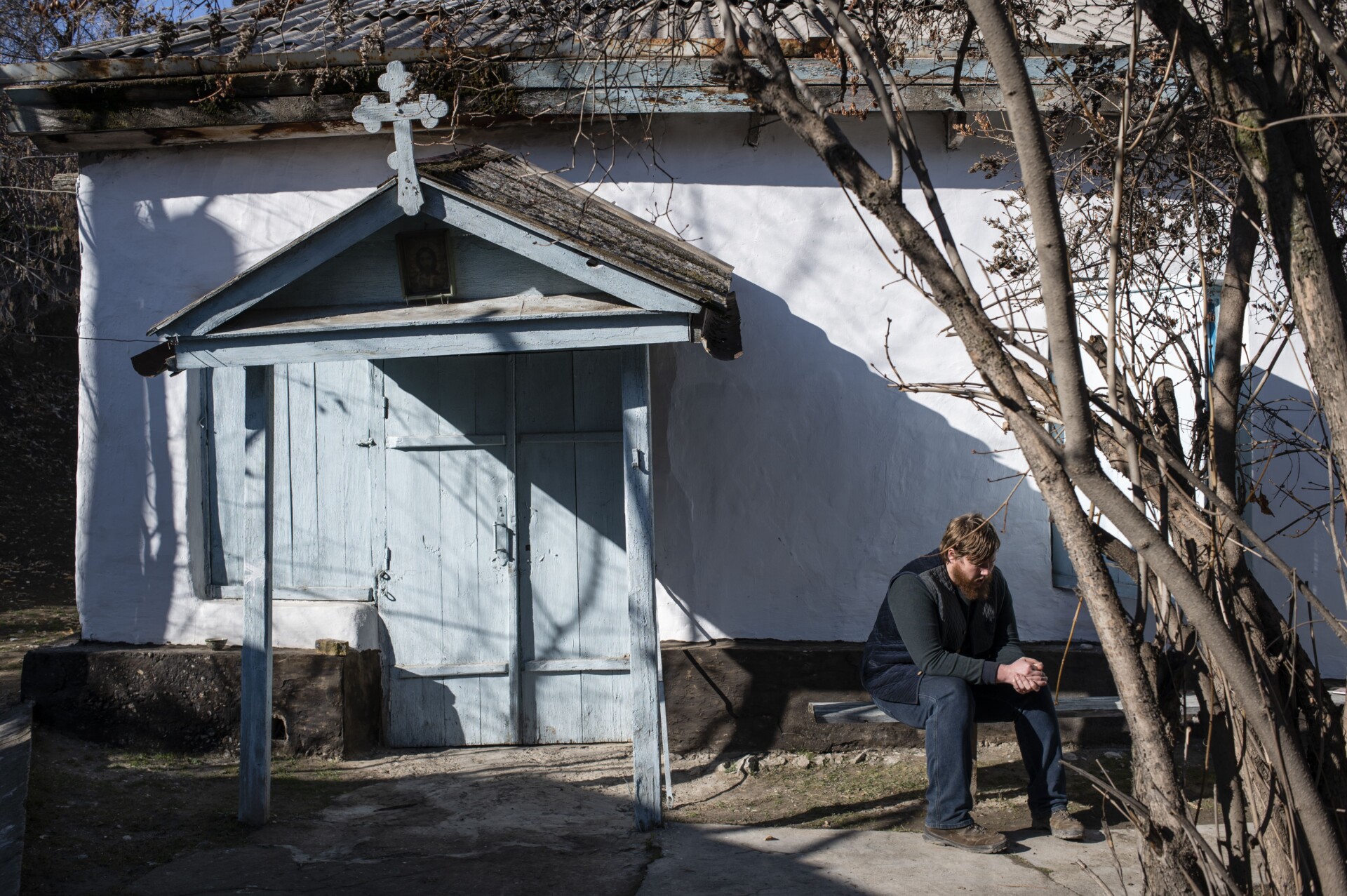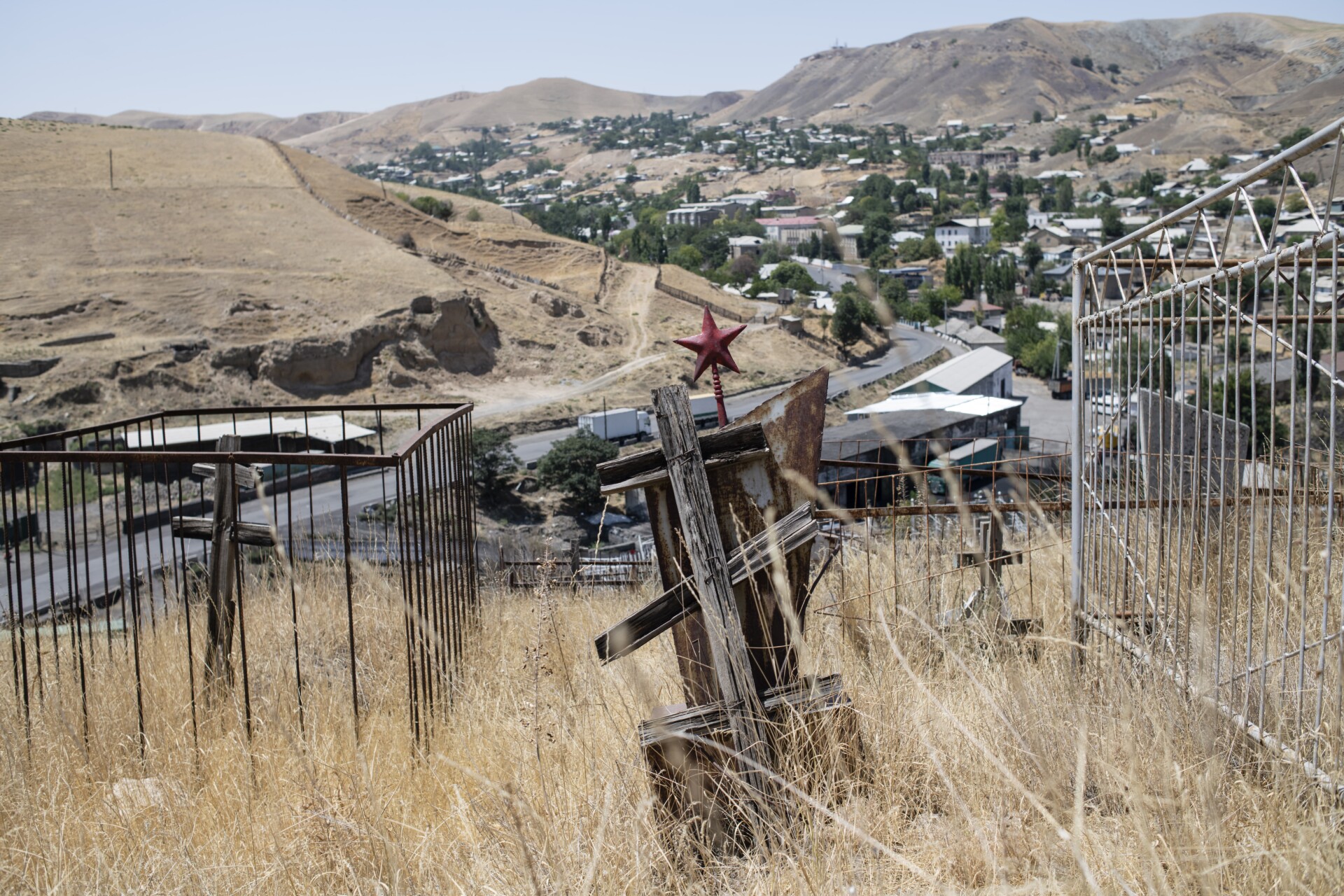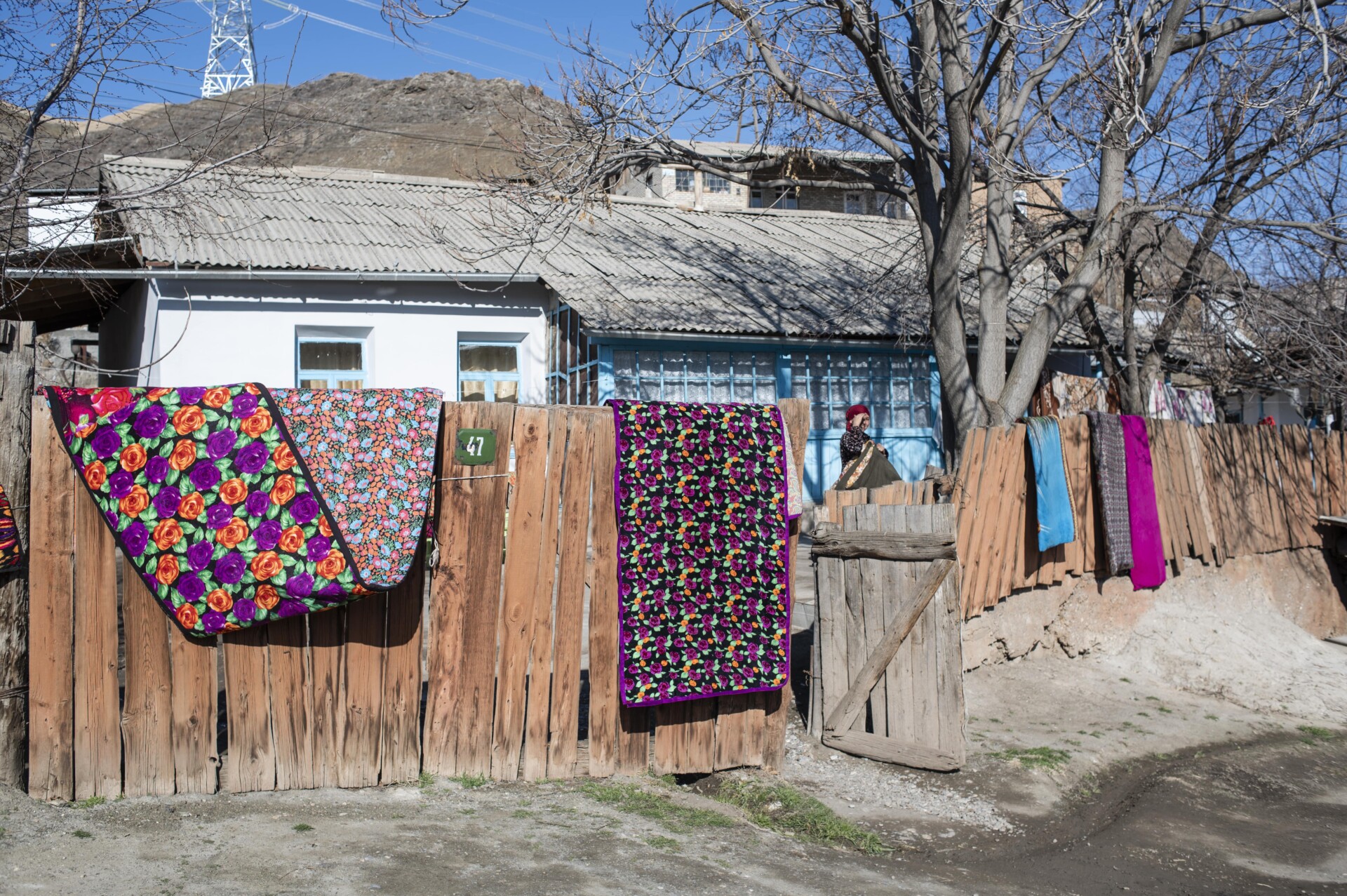It takes three hours to heat the church. The walls are cracked, and the window panes freeze in winter. The Rev. Dionisy Zorin starts up the coal stove at 5 in the morning. By 8 a.m., the temperature is just about bearable.
Twenty-seven-year-old Zorin came to Suluktu in October 2023.
He didn’t want to be assigned to this small town at the southwestern tip of Kyrgyzstan on the Tajik border. But as a young priest, he was eager to make his mark, even if that meant moving to a town of 24,000 people that is fighting unemployment and pollution from coal mining.
“Suluktu is a symbol of exile, a threat used against insubordinate priests,” Zorin says. But Kyrgyzstan’s eparch, a position in the Orthodox Church similar to a bishop, begged him, “Take a look at least.” So he did.
“I slept in the church and next morning decided I wanted to try. I saw a spiritual emptiness in the eyes of the people,” Zorin tells me in front of the church as we sit on a bench. If not for the cross, one could be forgiven for not knowing this small building, with its crooked porch and corrugated metal roof, is a church. The area is overgrown with bushes.
Suluktu is Zorin’s first parish, and it is far from easy. He is the first priest to be assigned to this remote town in 35 years. Twenty-seven locals petitioned the church authorities in Bishkek, the capital of Kyrgyzstan, writing a letter to request a priest after decades of waiting. They also wrote to the patriarchate in Moscow, where the Russian Orthodox Church is headquartered.
But when the young priest arrived, the petitioners were uninterested, even bordering on hostile. For all their pleas and hankering for spiritual nourishment, almost no one comes to his church services. Though he is ethnically Slav like many of the parishioners, they mostly see Zorin as a stranger. Born after the collapse of the Soviet Union in the early 1990s, he is well integrated into Kyrgyz society. Russia is his spiritual homeland, but he likes and feels patriotic toward Kyrgyzstan.
In this parish, in a desolate, far-flung spot of the former Soviet empire — closer to China than to Moscow — residents are faithful to Russia, or at least their idea of it. Though they have Kyrgyz citizenship, in their minds they remain loyal to the country that is long gone, the Soviet Union, whose mythology and past greatness still loom large for them.
This tiny Russian-speaking minority is now engulfed in a battle over who has the right to decide their heritage and their future. They nurture a private conviction of cultural superiority over their ethnically Kyrgyz neighbors — a phenomenon that plays out across the ex-Soviet countries of Central Asia and the Caucasus, wherever there are pockets of Slavic populations. They quarrel about who is the most “European” — essentially meaning Slav — among them, emphasizing their devotion to the Orthodox Church. The arrival of Zorin, an ethnic Russian with a Kyrgyz identity, has intensified their existential confrontation: Should he get to decide what to do with their church or should they? And if it is the parishioners, why can they not reach a compromise?
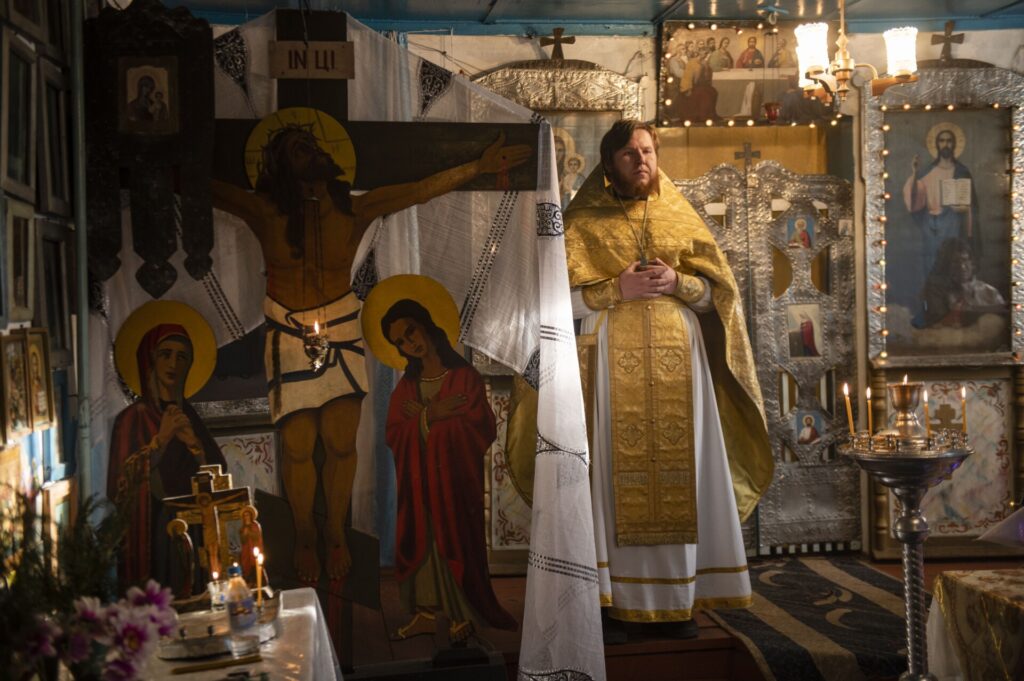
Zorin was born in the area of Issyk-Kul, a picturesque lake with azure waters that makes it one of Kyrgyzstan’s primary tourist attractions. It lies some 900 miles northeast of Suluktu. Zorin grew up among the Kyrgyz. If not for his Slavic facial features distinguishing him from his Asian compatriots, one would have thought Kyrgyz was his mother tongue.
He developed a fascination with the Orthodox Church after a Russian classmate took him there. The spectacle — “the clothes, smells, the show” — enveloped him, and he was entranced. It was then, at 14 years old, that he decided he wanted to become a priest.
His parents, both atheists, were not enthusiastic. But Zorin was determined. He graduated from the seminary of the Russian Orthodox Church in Tashkent, Uzbekistan, the top place to study in Central Asia for those wishing to enter the church. To be on the safe side, he also earned a degree in Kyrgyz literature. He even married. But this, he admits, was “to please my mother.” After a quick divorce, Zorin embraced celibacy.
“As a priest you’re constantly confronted with temptations,” he admits. Luckily, in Suluktu, where there are no places to meet women — no cinema or bookshop, and only a few cheap eateries — such temptations are few.
The young priest survives on a lean budget. The eparchy sends him the equivalent of $225 per month. Most of this is spent on the church. Any other income he earns in Osh, a city about 250 miles to the east of Suluktu. For half the month, Zorin teaches the Kyrgyz language there.
More often than not, he is a priest with few or no parishioners.
“As soon as I leave, people complain that the church is closed. When I’m back, no one visits. It’s schizophrenic,” he laments.
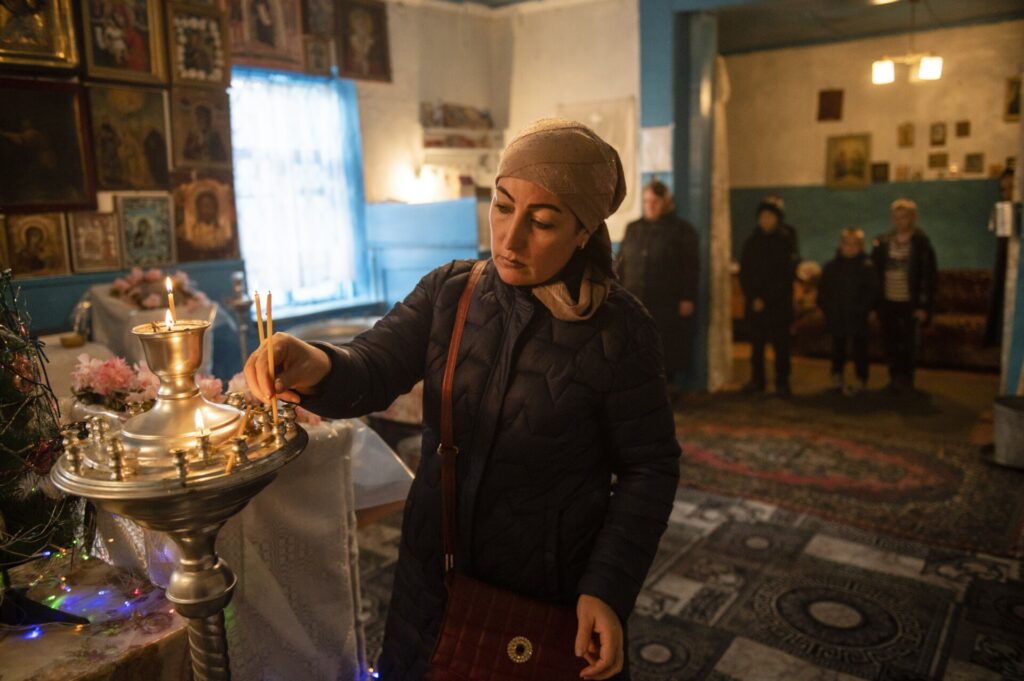
The Russian Orthodox Church was introduced in Kyrgyzstan when mostly Muslim Central Asia was incorporated into the Russian Empire in the second half of the 19th century. By the time of the October Revolution in 1917, when the Bolsheviks were sweeping to power, there were already 30 churches in what is now Kyrgyzstan. Some of them were destroyed during the purges of Josef Stalin, but many reopened during and after World War II.
Zorin’s church, whose full name is the Church of the Intercession of the Virgin Mary in Suluktu, opened in 1934. The clay building used to be the private house of a Tatar family.
“Formally it isn’t actually a church but a house of prayer,” Zorin admits. Normally, a sacred stone and a capsule with relics are placed under a properly founded Orthodox church, he stresses. In Suluktu there is no such stone or capsule. Zorin hopes to embed them when his renovation work begins in earnest.
The Orthodox Church of Kyrgyzstan is under the authority of the Moscow patriarchate. Before 2011, it was part of the eparchy in Tashkent. Later on, the Holy Synod of Russia created a separate Kyrgyz eparchy with its seat in Bishkek. Most believers are first- or second-generation Russians, Ukrainians and Belarussians, or a mixture.
Suluktu is the smallest of Kyrgyzstan’s 46 parishes and therefore not a priority for the church. Its “European” population is estimated to be upward of 740 people, according to the informal body of the Russian diaspora. Their ethnically Kyrgyz neighbors, who form the vast majority of the town, tend to regard them with contempt — at the Russians’ fondness for alcohol and, as they see it, for not taking proper care of their elderly, a taboo in Kyrgyz society. That is if they notice them at all.
“The majority of the Kyrgyz population can’t even tell that there is an Orthodox church in town,” said Suluktu’s mayor, Bolot Abdyjaparov.
No priest wanted to be appointed here. Most didn’t even want to visit. Within the past decade, three priests from other Orthodox parishes have come by. The priest from Kyzyl-Kyya, a town some 125 miles from Suluktu, wanted money thrown his way just to come and take a look. Another priest used to arrive drunk. And the third one was chased away for sexual misconduct, the locals say. After years of being deprived of pastoral care, the Suluktu residents became used to living in a state of spiritual neglect.
Zorin often spends all day waiting out in front of the church, hoping some will come inside to pray or take comfort in the holy surroundings. But out of the 27 people who signed the letter to the eparchy asking for a priest, only two regularly show up for services: a couple, Irina Belova, a devout 64-year-old, and Dmitri Nikitenko, a widower often glued to his smartphone watching weather patterns across the world.
They live together in a clay house built by German prisoners during World War II. Its floor is littered with clothes, and water drips from the drying wet laundry. Their metal beds give the place a sterile, hospital feel.
A Russian TV channel plays news from the front line in Ukraine.
Today, Belova is Zorin’s right-hand woman. She opens and closes the church when he is away. She recites prayers and sings at services. She also cooks for him and does his laundry. Belova says she discovered God when she was in her 30s.
“I felt light as a bird,” she recalls, her eyes glimmering. She had dreamed of becoming a nun, but her late husband was alive, preventing the Orthodox convents in Kyrgyzstan from accepting her.
When heavy rain collapsed one of the church walls in 2001, Belova was the first to collect the icons, some dating to the 16th century, from under the rubble. That night she slept in the church, guarding them from thieves.
The couple met at a construction site almost four decades ago and moved in together recently. “Out of convenience,” says Nikitenko, smiling. “It’s boring to be alone.”
A photograph of his late wife hangs above his bed. The couple’s children from previous marriages are scattered across former Soviet republics, symbolic of the decay and lack of opportunity in a place like Suluktu.
Belova’s oldest son, whom she calls “Father Mikhail,” is a clergyman in St. Petersburg. When he had his religious calling at a young age, the Suluktu residents collected money to send him to the Orthodox seminary in Tashkent, the same one that Zorin attended. After graduating, he was supposed to return and pastor the local church. But he chose Russia instead. In the 1990s, the Kyrgyz government initiated dynamic reforms that were to turn the state-controlled economy into a market economy. This shock therapy bankrupted many key industries. While the rest of Kyrgyzstan gradually recovered, the southern provinces — Batken (where Suluktu is), Osh and Jalal-Abad — had other problems to cope with. In Suluktu, the coal mines that had been established in the mid-19th century closed, plunging the town into unemployment. Many Russian-speaking residents left to look for jobs in Russia.
Belova also tried to leave. She followed her daughter, who found a job in Tolyatti on the Volga River in Russia. But Belova felt trapped in the big city with her daughter at work and her grandchildren away at school. Eventually, she packed her suitcase and returned to Kyrgyzstan. Now she sees her daughter and three sons, all of whom live in Russia, only on WhatsApp video calls.
Nikitenko’s children are split between Belarus and near the Sea of Azov, which sits between Ukraine and Russia. While he has visited both places, neither felt like home, so he also returned to Suluktu.
Other parishioners gossip about Belova and spread malicious rumors about her, including that she buried a newborn baby in her backyard. When asked about it, Belova quickly changes the subject. Belova has little time for slander; she is not well. After being diagnosed with breast cancer, she had a mastectomy, and a roll of toilet paper now sits in her bra. The cancer has now spread to her abdomen, and she is due for another round of surgery soon.
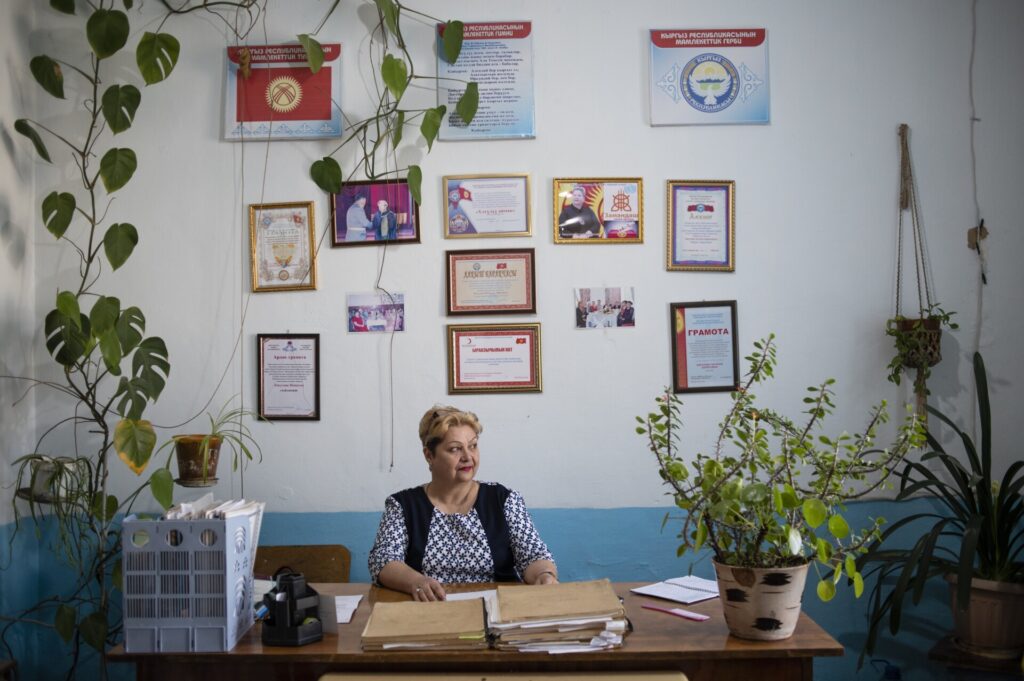
One of Belova’s main adversaries is Natalia Balakina, who co-wrote the letter to the Bishkek eparchy asking for a priest. The Suluktu church is personal for Natalia — her grandfather was an Orthodox priest who was brought from Tashkent in 1961 to oversee it, some eight years after Stalin’s death.
Belonging to the clergy in Soviet days was difficult, but he managed by working as a veterinarian and treating the horses of the Communist Party functionaries, which guaranteed him a secure, and elite, existence.
“There are very few of us Europeans here,” sighs 56-year-old Natalia from the sofa in her Soviet-built apartment on the outskirts of Suluktu.
Behind her are shelves packed with old porcelain and classic works of Russian literature. A giant teddy bear looks down on us — it is a mascot from the 1980 Moscow Olympics, a souvenir from a holiday in Russia long ago. Her younger sister, Aleksandra, has been to Russia three times. They include Ukrainians in the category of “European,” along with Tatars. But they call the rest, and majority, of the population in Kyrgyzstan — the Kyrgyz, Tajiks and Uzbeks — “nationals.” It carries with it a sharp racist undertone.
“Few Kyrgyz lived here before,” Natalia says of Suluktu with a grimace on her face. “It was a European town.” During the heyday of the Soviet Union, the state, in an effort to attract workers, offered high salaries and goods that were comparable to those of the main cities of Russia. Suluktu’s shops even sold the newest fashions from Moscow — a far cry from the town’s current increasing state of decay.
Their father, an engineer, built much of the town’s infrastructure, including the apartment complex where the sisters live. Perhaps that’s why they never left. “Only old and sick people remained, or such who have a particular connection to the town,” Natalia says. The sisters have both; their 82-year-old mother hasn’t left her bed for years because of a broken hip.
During the time of the Soviet Union, borders between the Central Asian republics mattered little. This changed after independence, and the delineation of the borders became a tedious and delicate task.
Large tracts along the nearly 620-mile-long border with Tajikistan still remain contested. Bloody interethnic clashes between the Kyrgyz and Uzbek populations shook the south of the country in 2010, contributing to the general feeling of insecurity and forcing non-Kyrgyz people to move. Tajikistan’s army attacked Kyrgyz territories in 2021 and 2022. Border clashes, which also occurred in the vicinity of Suluktu, claimed more than 200 lives; hundreds were displaced. It also explains why there are few ethnic Russians in the south of Kyrgyzstan compared with the north.
Natalia’s first husband also left for Russia. Her second husband, a miner, has been unemployed for years. The mines in Suluktu are now “in Kyrgyz hands,” she complains, alleging that they don’t want to employ Russians. Her older son hanged himself; the younger has epilepsy.
Aleksandra is not much happier than her sister. For two years she has worn only black, after her husband died of cancer. United in sorrow, the two sisters set themselves the ambitious goal of building a new church. Their public foundation, called “Heritage” (“Nasledie” in Russian), began collecting donations and employed an architect who declared the old church building unsafe. It still bears the marks of a fire caused by a faulty electrical installation. After the wall collapsed, a metal frame was introduced to hold the walls together.
The building is situated on municipal land, and in 2022, the mayor suggested that the parish find a new plot on the outskirts. Zorin is planning a major renovation of the church, but the sisters prefer the land swap. He is suspicious of them — they do not attend his services. To be on the safe side, he has deposited all the church’s documents with a lawyer in Osh. “If something happens, he will know what to do.
“The town may look peaceful, but a war of empires is going on here,” Zorin says. “Protestants get money from South Korea and the United States, and Muslims from the Gulf countries. It’s only us who barely manage to make ends meet.” After the collapse of the Soviet Union in 1991, and after the Central Asian republics gained their independence, a string of countries became the key investors in the construction of mosques in the region, namely Saudi Arabia, Turkey, Qatar and the United Arab Emirates. In the three decades since independence, the mosques in Suluktu grew in number from one to 52 — in all of Kyrgyzstan, from a few dozen to over 2,000.
Islam remains the primary faith in the country, but the state is secular, and the constitution guarantees freedom of religion. Over 3,000 religious organizations are registered with the State Commission for Religious Affairs; nearly 400 of those are Christian. Estimates vary, but Christians are believed to constitute up to 7% of Kyrgyzstan’s religious population. Within that percentage, the majority are Orthodox, followed by Roman Catholics and Protestants. Evangelical churches from North America, South Korea and Europe became especially active throughout the post-Soviet world in the 1990s. The Suluktu residents are convinced that South Koreans sponsored the local Adventists and even call them a “Korean church.” The head of the Adventists in Suluktu confirms that he received his training in South Korea but says that his church subsists on donations from within Kyrgyzstan.
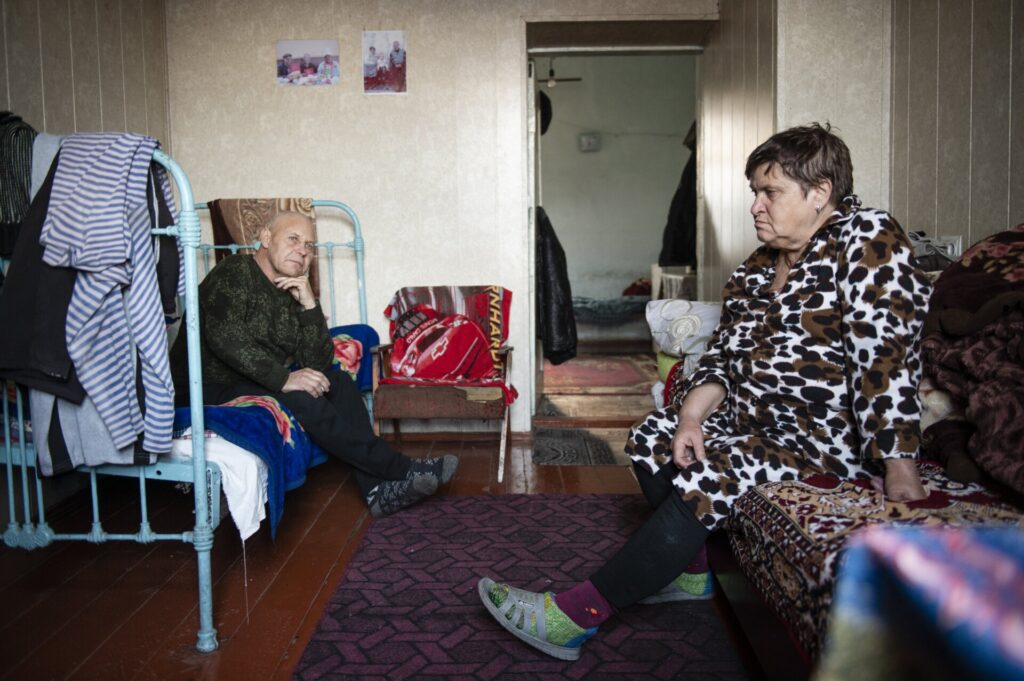
Natalia Bikulova, an energetic 59-year-old, is the town’s informal head of the Russian diaspora. She is a self-described workaholic, toiling away in an office serving the city, coordinating distributions of coal and basic supplies like food. She is the first point of contact when the lights go off or when water stops running from the tap — events that happen regularly in Suluktu.
Like the Balakina sisters, she is also dissatisfied with Zorin’s management of the church. Bikulova is immensely attached to it, having attended since the late 1980s, discovering her Orthodox identity as communism collapsed around her. By 1989, the last priest had already left and old women were taking care of the church. A decade later, Bikulova became a “starosta” — a person responsible for maintaining the parish. She even learned how to conduct funerals; she would call the eparchy in Bishkek to ask which prayers should be read.
“We were left alone and learned to do things on our own,” she says.
She now goes to Zorin’s church services but thinks he has done a terrible job of renovating.
“Father Dionisy has big ambitions but no social skills,” she says. “Have you seen that ugly blue? Our church used to be so beautiful!” she says with disdain, adding that the previous shade of blue was more inviting.
Bikulova was born in the town of Legnica, Poland, which was the location of a forced-labor and POW camp during World War II. Until 1993, Soviet-mandated troops were stationed in Legnica because it was close to the German border. Bikulova learned military drills as she grew up there. Then she went to Tashkent in the then-Soviet Union to study, later relocating to Suluktu with her husband. Like many, she first worked in the coal mine as a fuel supply manager. “It was always loud, so I had to shout at the drivers. Since then, I always speak louder than necessary, but it comes handy in life.” Unlike the other “Europeans” in Suluktu, she was born in Poland, she proudly tells me.
She won’t discuss her feelings on Zorin with the Balakina sisters, whom she accuses of stealing money the diaspora had collected to renovate the Orthodox cemetery. As for Belova, she believes the local gossip. “This woman is a sinner.”
Bikulova’s calendar is arranged around former Soviet holidays. She organizes community events on Victory Day or the anniversary of the October Revolution. Like many others of her generation, her children live in Russia. She has promised them she will join them once she retires.
“This town was built thanks to the Soviet Union,” she says. “But Russia forgot about us later.”
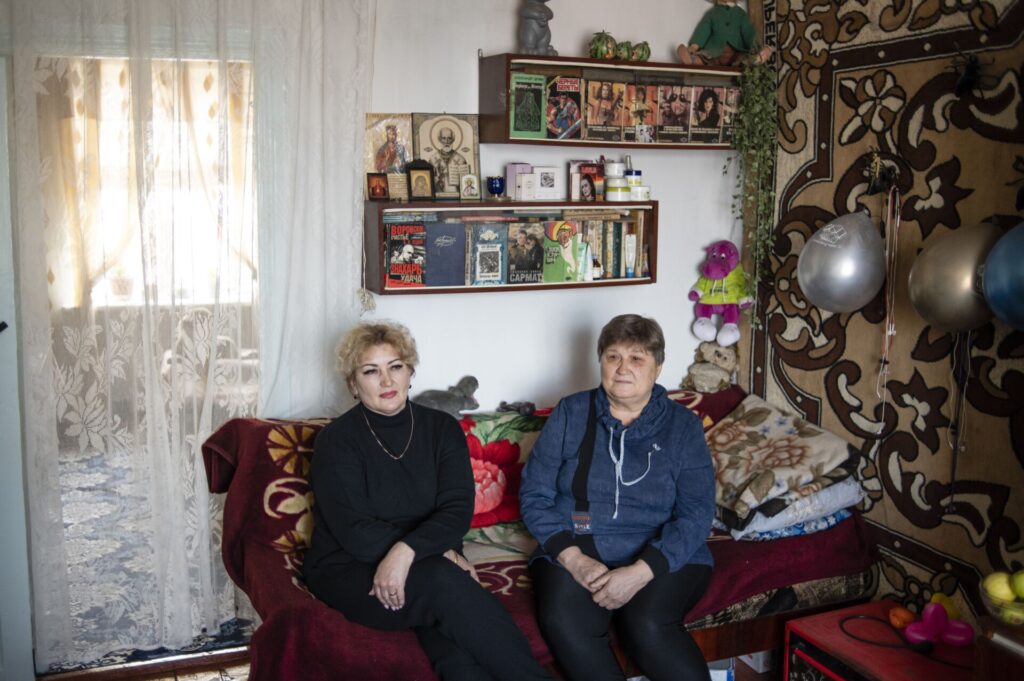
In January, Zorin was busy organizing to celebrate the Epiphany, the Orthodox holiday marking the baptism of Jesus in the Jordan River. (According to the Julian calendar used by the Russian Orthodox Church, Epiphany falls on Jan. 19, some 13 days later than the rest of the world’s Gregorian calendar.) On the eve of Epiphany, Zorin held a fireworks show. Fifteen people came, including some Kyrgyz children from the neighborhood. Zorin welcomed everyone and recited a short prayer.
Ahead of the holiday, Zorin posted in a WhatsApp chat the community uses called “Russkaya diaspora” (“Russian diaspora”). “Brothers and sisters, please come to take the holy water. It heals the wounds of body and soul.”
Hardly anyone heeds his message.
“On the Epiphany night God blesses all water in the universe,” says Aleksandra. “We don’t need a priest for that.” One of the Kyrgyz boys helped Zorin fetch the water for the celebration; bathing in ice-cold water is a tradition in the Russian Orthodox Church. But there are no streams or rivers in Suluktu, so the only option for the parishioners is to douse themselves with water in the churchyard. Zorin heats the water for Belova before pouring two buckets on her head. She shivers but tells herself it will help fight the cancer.
The young priest’s enthusiasm is slowly wearing off.
“My job is to pray. So, I pray. But inside it hurts. My therapist helps me organize my emotions, but I fail,” he says. His reliance on tranquilizers has led the local pharmacy to give him a discount for them.
He plans to bring in an eparch from Bishkek. “I want him to see this empty church,” he says. “And I will ask that they move me to Mailuu-Suu,” a mining town in southern Kyrgyzstan. The town was once one of the main uranium processing centers; the first Soviet atomic bomb to be detonated, in 1949, used uranium from Mailuu-Suu. Today it is considered one of the most polluted places on Earth, surrounded by radioactive waste. This does not dissuade Zorin. “Never mind the radiation! There are people there!” he says gleefully, describing how it is home to 3,000 Russians, 2,000 Ukrainians and many Tatars.
“Here I feel like a one-man show, but I need an audience,” he says. He hopes Mailuu-Suu is his next steppingstone. He then wants to become a metropolitan — a high-ranking bishop — perhaps even reaching Moscow one day.
This article was published in the Fall 2024 issue of New Lines‘ print edition.
Sign up to our mailing list to receive our stories in your inbox.




